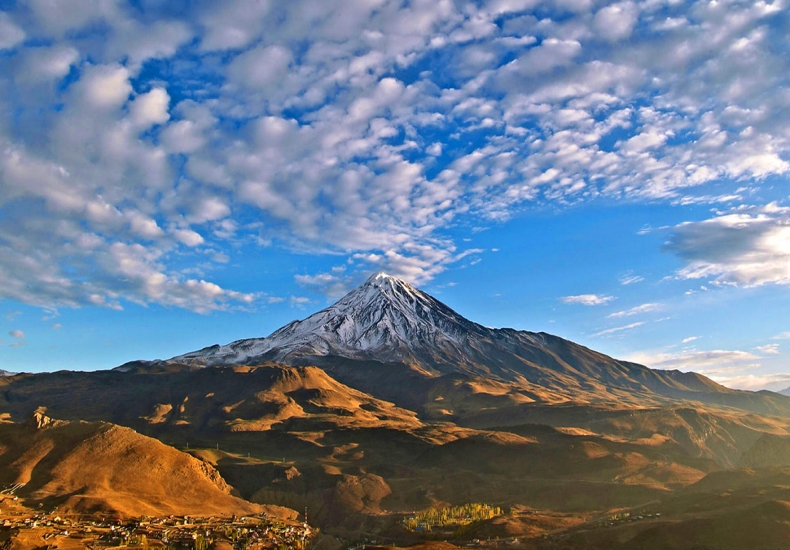Mount Damavand not only is the highest peak in Iran, but it’s the highest peak in the Middle East. Kulun Volcanic Group in Tibet, is higher than Damavand but given that they are not considered volcanic mountains, Damavand is the highest volcanic peak in Asia, located in the northeast Tehran, about 66 kilometers (41miles) from the capital, eastern side of Lar National Park. Near the southern coast of Caspian Sea, in Amol, a county located in Mazandaran province.
One of the highest and most prominent mountains in the world, mount Damavand has ranked 12th among other prominent mountains and gained the 2nd position in Asia after mount Everest.
The conical shaped, mount Damavand is considered to be a stratovolcano (a potentially active volcano), is the highest volcanic mountain in Asia. There are seven summits that are considered mountaineering challenges to the mountaineers and climbers, in other words are on every professional climber’s bucket list. Damavand is part of these Volcanic Seven Summits.
The mount Damavand also plays a significant role in Persian mythology.
The volcanic and conical shaped mountain of Damavand is 5610 meters high.
Mount Damavand is the symbol of strength. In Persian poetry Damavand is a symbol of resistance to despotism and ruling of the foreigners. According to Zoroastrian texts and myths, a three headed monster called Azi Dahaka is chained within the mountain and stays there to the end of time. A tyrant called Zahak was also mentioned to be chained inside of a cave in the mountain, according to later versions of this legend. Ferdowsi has depicted this in his famous Shahnameh.
It is also believed that during a border dispute between Iran and Turan, a magical arrow was shot by Arash (one of the legendary heroes of Persian poetry and culture), and marked the landing point of the arrow as the border between Iran and Turan.
As a volcanic mountain, with a wide caldera of about 9 km, this magnificent beauty was first erupted about 1.78 million years ago during the recent periods of repeated glaciations of the earth. Damavand has had several eruptions with some main eruptions around 600, 000 and 280,000 years ago. Its last eruption was around 5300 BC and during the current warmth period of the planet earth.
Regarding its geology, the steep sides of mount Damavand consists of layers of ash and flowing lava, turned into volcanic rocks. Lava flows consisted mostly of basalt, andesite, trachyte. Sulfuric gases are still deposited out of the summit’s crater. Fumaroles emitting sulphurous gases near the crater, indicates that mount Damavand is potentially active.
Mineral hot springs at the base of the mountain and at the lower levels, and fumaroles on higher altitudes, are the evidences of volcanic activity near the surface, and existing hot or cooling magma beneath the volcano. Ab-e – Garm Larijan hot springs are the most significant and important hot springs of Damavand mountain, named after the village it’s located in, Larijan in valley of Lar. There are public baths located near these hot springs for public use, to treat chronic wounds and skin diseases.
As one of Iran’s highlights, mount Damavand is a must see. There are two options too see the mount Damavand. You can either watch it from afar and from various points that we’ll mention below, and the other choice is to climb the mountain.
On a clear day you can see mount Damavand from Tehran. This is probably the farthest view of Damavand. But to better gaze at the beauty of this mountain without climbing it, you can head to Polour village, located on Haraz river, in the rural district of Bala Larijan, Amol county, Mazandaran province. Polour is located in about 100 kilometers of Tehran heading north east. Another breathtaking view of mount Damavand is from Lar national park.
To see Damavand up close, you will have to climb the mountain. Depending on your strength level and route difficulty, there are currently 16 known routes to the summit. Some of them are dangerous and require rock climbing. So far the easiest route is the southern face of the mountain which is equipped with steps, and midway camps at 3000 and 4150 meters. One of them is called Bargah Sevvom camp or shelter. The longest route is from the north eastern face, which from the starting point of Nandal village, it takes about two days to reach the summit and requires one night stay at Takht- e- Fereydoun, a two story shelter at the altitude of 4300m. Western face is popular for it’s breathtaking sunset view and there’s a two story shelter at 4100 m.
Climbers who have made it to the top, admit that the last 300 meters are the toughest, due to sulphurous gasses which can not be avoided.
For those who are a fan of trekking, our specialists can arrange your trip to Damavand mountain through our Iran tours. Iran tourism due to the many existing options, is not limited to just cultural tours so tourists can enjoy any Iran tourism activity, through the Iran tours (of any profile and type).
If you like physical activities, through Iran tours, you can travel to Iran and visit the Iran highlights specific to this type of activity. The best time to travel to Iran and enjoy these types of activities is during spring and fall. We can prepare your travel to Iran, offering you the best services like Iran visa, Iran tours, any kind of transfer and/or transportation and many other services.


24/7
Free